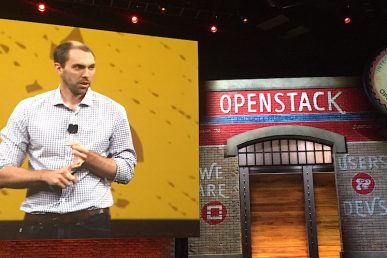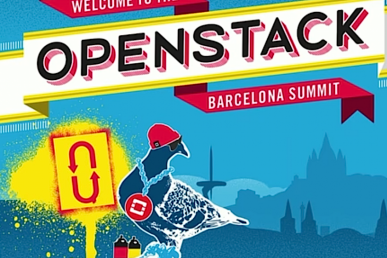AUSTIN, Texas — It’s been a long road home but an amazing journey.
The keynote kicked off with the OpenStack Foundation’s Todd Morey and Lauren Sell talking about the early days when some 75 people met for the first Summit in Austin back in 2010. Then they welcomed a packed house of 7,500 people to the Austin convention center today.
Love seeing so many Women of #OpenStack on the #OpenStackSummit keynote stage #WeAreOpenStack pic.twitter.com/0SBh9Yw5K8
— Allison Price (@amprice88) April 25, 2016
Many of the 2,336 developers from 345 companies who contributed to Mitaka, the 13th release, were in the house. OpenStack Foundation executive director Jonathan Bryce asked them to stand up for a round of applause for making the release, which focuses on release focused on manageability, scalability and user experience.
"Times of disruption are the times of greatest opportunity – capture the value to accelerate your business," said Bryce, noting that OpenStack isn’t about business as usual – it’s part of a larger, ongoing disruption. "If you get the culture right and the process right being big is not a disadvantage in winning the disruption," he said.
. @jbryce says half the Fortune 100 now use #OpenStack & majority want to standardize for priv/pub #OpenStackSummit pic.twitter.com/6Aj4Eei7ed
— Ryan McAdams (@ryanmcadams) April 25, 2016
Switching gears with Bimodal IT
Donna Scott, Gartner distinguished analyst, took the stage accompanied by “Long Shot Lady” played by local band Soul Track Mind who kept things lively with tunes coming out of the Stackers Barn onstage.
Scott spoke of companies working in two modes, predictable (Mode 1) and exploratory (Mode 2), and the arduous task of switching between them for growth. Bimodal is correlated to digital workplace performance — by 2020, 41 percent of executives said that revenue would come from digital business, she said. This "bimodal" way of working is often seen as a nightmare, especially for those who find themselves caught in between. There are misconceptions, she said, about bimodal IT being bad."You need both," she said, adding that OpenStack is critical for Mode 2. "Where you don’t have the path cut yet, those projects are born in the cloud."
She made five recommendations:
● Invest in bimodal
● Know that it means more than agile development
● Incentivize collaboration between Mode 1 and Mode 2
● Scale Mode 2. When uncertainty diminishes and you need the predictability and stability that
● Start your OpenStack initiative with Mode 2. Then over time, refactor and onboard Mode 1.
Judging by the audience reaction, today’s turnaround was a long time coming. As late as 2013, Gartner still said that OpenStack wasn’t ready for prime time.
https://twitter.com/FURIOUSSTACKER/status/724636292202565637
Embracing diversity
"OpenStack is a strategy for taking advantage of diversity in IT," says Bryce. The keys to embracing diversity include picking the right platform and remembering that new apps need old apps — data from a system of record. As we look at the trends that are driving business value across many industries–big data analytics, containerization, continuous delivery, NFV, the Internet of Things, and more–it’s clear that our industry will continue to be an exciting, diverse and challenging environment. Bryce also outlined his thoughts in a Superuser magazine editorial, pick up a copy if you’re at the Summit.
Vodka bear
If you like your keynotes shaken and stirred, Mirantis has got something for you. Instead of the usual soporific videos, they showed this clip.
http://www.youtube.com/watch?v=QDJVvhS1Ayo
Then Boris Renski, co-founder and CMO at Mirantis, took the stage with a vodka-drinking bear. This is a good time to be in the cloud, he said, and not just because Gartner has come around. Amazon web services is a tiny portion of the full IT Market waiting to be "cloudified."He broke down a previous Gartner pie chart about why OpenStack often stumbles into easy-to-grasp sound bites: "success with OpenStack is one part tech and nine parts people and process."
"We like Gartner at Mirantis now that they are not saying that OpenStack is cr@p" – the Mirantis bear emerges 🙂 pic.twitter.com/onj9pIYAN0
— Simon Anderson (@S1monAnd) April 25, 2016
Renski also spoke of reconciling data center diversity – putting it in terms of getting the private cloud DevOps ninjas to play nice with the VMware Sys admin bears that earned him a round of applause from the audience.
I just saw a savage animal rocking the #openstacksummit stage. Oh, and there was a bear too. @zer0tweets (btw, it was perfect)
— Karol Stępniewski (@kars7e) April 25, 2016
A rainbow of Superusers
AT&T took the stage to talk about their ground-breaking journey with OpenStack, Sorabh Saxena started with some startling factoids including that mobile traffic grew 150,000 percent from 2007-2015.
He ended with a call to action and a warning by inviting every one present to help solve issues for large scale operators and make Openstack the standard for private clouds. "You either lead disruption by being in driver’s seat or you’re just a passenger," he said.
AT&T also took home the fourth Superuser Award, beating out teams from Dreamhost, Betfair and Workday.
A number of users also hit the stage to talk about OpenStack, including SAP, Volkswagen and Red Hat, whose Chris Wright also underlined the importance of diversity.
"Diversity is not just about the code but is about the actual community members itself." –@kernelcdub #OpenStack pic.twitter.com/EkIBBp3w7c
— Red Hat Events (@RedHatEvents) April 25, 2016
If you missed the keynote, you can catch the videos here: https://www.openstack.org/videos
Stay tuned for more news from Austin!
Cover photo: OpenStack Foundation, Johnathan Bryce on the keynote stage.
- Exploring the Open Infrastructure Blueprint: Huawei Dual Engine - September 25, 2024
- Open Infrastructure Blueprint: Atmosphere Deep Dive - September 18, 2024
- Datacomm’s Success Story: Launching A New Data Center Seamlessly With FishOS - September 12, 2024

)










